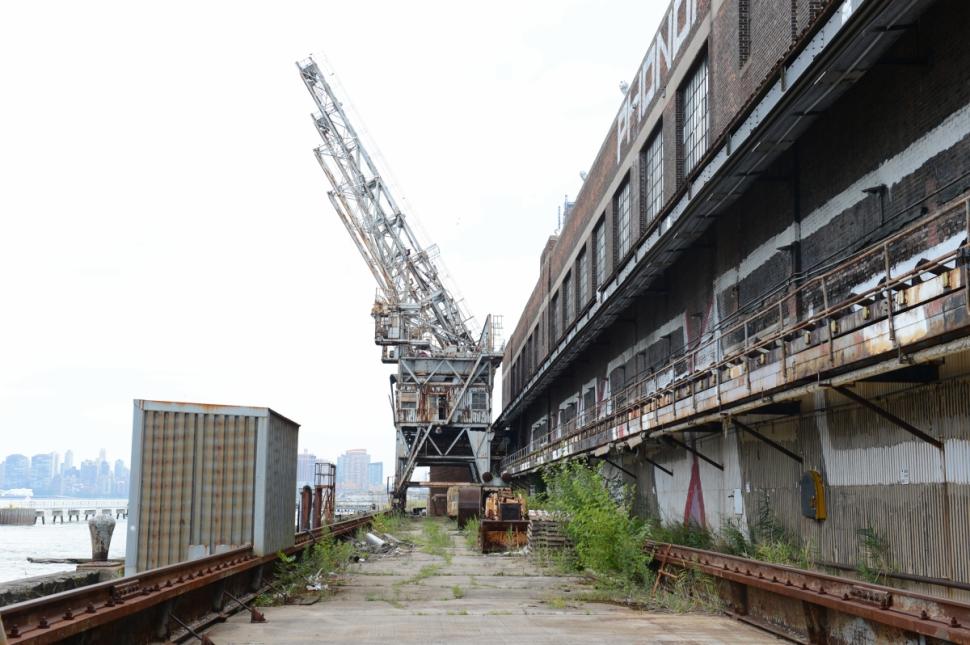Katherine Clarke reports for The Daily News: Salvage operation at Domino Sugar factory tops $10M as developers look to rescue industrial artifacts.
The iconic Domino Sugar factory sign and other artifacts are being salvaged and will return once the $1.5 billion project is completed.
The developers of Williamsburg’s iconic Domino Sugar Factory say the 40-foot yellow neon sign which has adorned the property since the 1920s will return — once a $1.5 billion redevelopment of the site is completed. And the sign, in the process of being temporarily removed, is hardly the only artifact being salvaged from the site, once home to the largest sugar-refining operation in the world. Landscape architects and preservationists have been like kids in a candy factory, raiding the site for relics. The relics speak to the area’s rich industrial past. And they can and will be incorporated into a brand-new waterfront park at the site. “The demolition contractors wanted to kill me because I kept finding things I wanted to keep,” said Lisa Switkin, a landscape architect with James Corner Field Operations.
The firm has been tapped by developer Two Trees Management Company to design the park. The salvage operation is now more important than ever, as Two Trees prepares to raze the majority of the factory buildings. And the salvation efforts may help assuage the anger of some neighborhood residents, who have long opposed the redevelopment of the site on the grounds of historical significance. Some concerns about the project were already put to bed earlier this year. That happened when Two Trees, headed by the Walentas family, agreed to up the number of affordable housing units included in its plans, from 660 apartments to 700. Two Trees also plans to build more than 2,000 rental apartment units, retail space and a school, in addition to the five acres of waterfront open space.
The wrecking ball is finally rolling after years of discussion. The so-called bin structure, on which the Domino sign is prominently displayed, is slated to be demolished by the end of August. And under the company’s current construction schedule, most of the property’s buildings will be gone by the end of the year. But the main refinery building, complete with its distinctive chimney and protected by a landmarks law, will remain. Plans call for that structure to be transformed into an office hub for technology and creative companies.
Switkin’s firm is drawing inspiration for the park from one of its biggest projects, the High Line, which the company spent five years masterminding. The Domino park will feature a similarly elevated catwalk. It will be abutted on one end by two salvaged 80-foot-tall gantry cranes, which were once used to unload raw sugar from freighters when the product arrived on ships from Latin America and the Caribbean. The runway, to be known as the Artifact Walk, will run the length of the 505-foot-long sugar warehouse currently housed on the site. That’s where the sugar was first stored before being pumped up into the main refinery. The warehouse recently played host to an enormous art installation by Kara Walker. For Switkin, salvaging these kinds of objects is a way to leverage the area’s industrial heritage and to add character and context to the park, all while adding value to the apartments and office space going up on the site. In the 1950s, when production peaked at the facility, there were more than 5,000 workers active at the factory. Up to 1,500 tons of sugar were refined there every day. “If you lived on Kent Ave., some mornings you’d wake up to find a thick sugar coating on your car,” said Dave Lombino, the director of special projects at Two Trees. When the company began the project nearly a year ago, visitors to the site were instructed to wear throwaway shoes. The floors were still sticky from molasses.
The park will feature an elevated catwalk, abutted on one end by two salvaged 80-foot-tall gantry cranes, which were once used to unload raw sugar from freighters when the product arrived on ships from Latin America and the Caribbean.
The developer is also salvaging the 425-foot long rail tracks. They supported the cranes and a series of structural columns from the sugar warehouse, still caked in sugary lumps, which will serve as a backbone for the catwalk. Other artifacts to be rescued from the rubble include: cylindrical tanks that collected syrup during the refining process, mooring bollards and bucket elevators. Switkin is even planning to restore various dials, meters and valves from old refinery machines. They’ll be incorporated into a play area for children in the park.
The process of salvaging these items is expensive and time-consuming, but Two Trees will likely get its money back out on the other end. A representative company estimated the cost of the salvage operation at more than $10 million. “It’s not pure altruism on our part,” Lombino admits. “We’re renting a couple of thousand apartments here. The more this place is desirable as an attraction, the more intriguing the history seems, the more we’ll be able to rent them for.” For its part, the Brooklyn Historical Society is happy with Two Trees’ preservation efforts and is helping the company to curate a small exhibition about the factory’s past. The show will be displayed in the refinery building once it opens. “Some people will always be unhappy about the development of the site,” says society president Deborah Schwartz. “But Two Trees has no desire to wipe out the history. They’re giving the community an opportunity to remain connected to the story of the site.”







